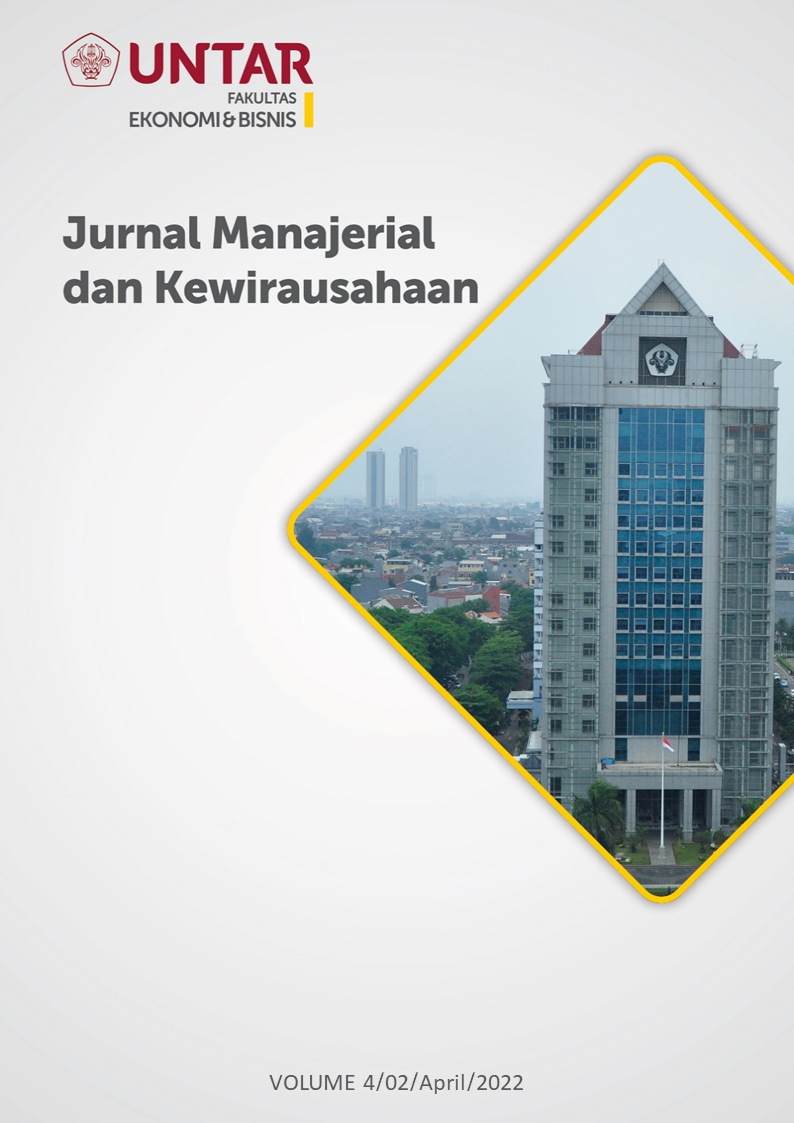Pengaruh Pendidikan Kewirausahaan, Pengambilan Risiko, dan Efikasi Diri terhadap Niat Berwirausaha
Main Article Content
Abstract
Tujuan dari penelitian ini adalah untuk menjelaskan pendidikan kewirausahaan, pengambilan risiko dan efikasi diri terhadap niat berwirausaha pada Mahasiswa Universitas Tarumanagara. Desain penelitian yang digunakan dalam penelitian ini adalah desain penelitian deskriptif. Populasi dari penelitian ini adalah Mahasiswa Manajemen Kewirausahaan Universitas Tarumanagara. Metode pengambilan sampel yang digunakan dalam penelitian adalah non probability sampling dengan teknik purposive sampling. Sampel dari penelitian ini sebesar 200 responden. Teknik pengumpulan data dilakukan melalui kuesioner dan diolah melalui SmartPLS. Hasil yang dihasilkan dalam penelitian ini adalah pendidikan berwirausaha, pengambilan risiko dan efikasi diri memiliki pengaruh positif dan signifikan terhadap niat berwirausaha.
The purpose of this research is to explain of entrepreneurship education, risk taking, and self-efficacy towards entrepreneurial intention of Tarumanagara University Students. The design used in this study is a descriptive research design. The population of this research is Tarumanagara University Entrepreneurship Management Students. The methdod used in this research was non probability sampling with purposive sampling technique. The sampel of this research is 200 respondents. Data are collected by using questionnaire and processed by SmartPLS program. The result of this research is entrepreurship education, risk taking, and has a positive and significant effect on entrepreneurial intention.
Article Details
This work is licensed under a Jurnal Muara Ilmu Ekonomi dan Bisnis Creative Commons Attribution-ShareAlike 4.0 International License.,/p>
References
Adnyana, I. G. L. A. dan Purnami, N. M. (2016). Pengaruh Pendidikan Kewirausahaan, Self Efficacy Dan Locus of Control Pada Niat Berwirausaha. E-Jurnal Manajemen Unud, 5(2), 1160–1188.
Antoncic, B., Auer Antoncic, J. and Gantar, M. (2012). Risk-taking propensity of entrepreneurs and their non-persistence in entrepreneurship. In Antoncic, B. (Ed.). Advances in Business-Related Scientific Research Conference — ABSRC 2012, Olbia, Italy, September 5–7, 2012. Conference Proceedings. Koper: Edukator.
Badan Pusat Statistik. (2020) Februari 2020 Tingkat Pengangguran Terbuka (TPT).
Bandura, A. (1997). Self-Efficacy, the Exercise of Control. New York: W.H. Freeman and compan.
Cromie, S., (2000) Assessing entrepreneurial inclinations: some approaches and empirical evidence. European Journal of Work and Organizational Psychology, 9(1), 7-30.
Daniel dan Handoyo, S. E. (2021). Pengaruh Pendidikan Kewirausahaan, Lingkungan, dan Motivasi Berwirausaha terhadap Intensi Berwirausaha Mahasiswa. Jurnal Manajerial dan Kewirausahaan, 3(4), 944–952. https://doi.org/10.24912/jmk.v3i4.13436
Drost, E. A., & Mcguire, S. J. J. (2011). Fostering Entrepreneurship among Finnish Business Students: Antecedents of Entrepreneurial Intent and Implications for Entrepreneurship Education. International Review of Entrepreneurship, 9(2), 83–112.
Dwi Hadya Jayani (2019). Peringkat Kewirausahaan Indonesia Nomor Dua Terendah di ASEAN. Retrived 9 September, 2021, from https://databoks.katadata.co.id/datapublish/2019/10/04/peringkat-kewirausahaan-indonesia-nomor-dua-terendah-di-asean.
Ediagbonya, K. (2013). The roles of entrepreneurship education in ensuring economic empowerment and development. Journal of Business Administration and Education, 4(1), 35-46.
Fayolle, A., & Gailly, B. (2015) “The impact of entrepreneurship education on entrepreneurial attitudes and intention: hysteresis and persistence.” J Small Bus Manag, 53(1), 75-93.
Frank, H., Korunka, C., Lueger, M., & Mugler, J. (2005) “Entrepreneurial orientation and education in Austrian secondary schools.” Journal of Small Business and Enterprise Development, 12(2), 259-273.
Gerba. D. T., (2012). “Impact of entrepreneurship education on entrepreneurial intentions of business and engineering students in Ethiopia.” African Journal of Economic and Management Studies, 3(2), 258-277.
Hair Jr, J. F., Sarstedt, M., Hopkins, L., & Kuppelwieser, V. G. (2014) “Partial Least Squares Structural Equation Modeling (PLS-SEM): an emerging tool in business research.” European Business Review, 26(2), 106-121.
Indahsari, L. dan Puspitowati, I. (2021). Pengaruh Pendidikan Kewirausahaan Dan Efikasi Diri Terhadap Minat Berwirausaha. Jurnal Manajerial dan Kewirausahaan, 3(1), 267–276. https://doi.org/10.24912/jmk.v3i1.11320
Jain, R., & Ali, S.W. (2013). A review of facilitators, barriers and gateways to entrepreneurship: Directions for future research. South Asian Journal of Management, 20, 122-163.
Jonathan, S. (2006). Metode Penelitian Kuantitatif dan Kualitatif. Yogyakarta: Graha Ilmu.
Katz, J., dan W. Gartner, 1988. “Properties of emerging organizations”. Academy of Management Review 13 (3): 429-441.
Kirby, D. (2004). Entrepreneurship education: can business schools meet the challenge? Education Training, Vol. 46 + No 8/9, pp. 510-19.
Markman, G. D., Balkin, D. B., & Baron, R. A. (2002). Inventors and New Venture Formation: The Effects of General Self-Efficacy and Regretful Thinking. Entrepreneurship Theory and Practice, 27(2), 149–165. https://doi.org/10.1111/1540-8520.00009.
Nursalam. (2013). Kewirausahaan. Journal of Chemical Information and Modeling, 53(9), 1689–1699.
Ormrod, J., E. (2008). Psikologi Pendidikan (membantu siswa tumbuh dan berkembang jilid 2). Jakarta: Erlangga.
Praag, C.M., & Cramer, J.S. (2002). The roots of entrepreneurship and labour demand: individual ability and low risk. Economica, 68, (259), 45-62.
Sekaran, Uma dan Bougie, Roger. (2016). Research Methods For Business: A Skill Building Approach, 7th Edition. New Jersey: Wiley
Soehadi, A.W., Suhartanto, E., Winarto, V., & Kusmulyono, M.S. (2011). Prasetiya Mulya EDC on Entrepreneurship Education. Seri Kewirausahaan 1. Penerbit Prasetiya Mulya Publishing. Jakarta.
Sugiyono. (2006). Metode Penelitian Kuantitatif Kualitatif dan R&D. Bandung: Alfabeta.
Tu, B., Bhowmik, R., Hasan, M. K., Asheq, A. Al, Rahaman, M. A., & Chen, X. (2021). Graduate students’ behavioral intention of toward social entrepreneurship: Role of social vision, innovativeness, social proactiveness, and risk taking. Sustainability (Switzerland), 13(11). https://doi.org/10.3390/su13116386
Wibowo, A. C., & Suasana, I. G. A. K. G. (2017). Pengaruh Efikasi Diri, Pengambilan Risiko, Dan Inovasi Terhadap Niat Berwirausaha Mahasiswa Feb Universitas Udayana. E-Jurnal Manajemen Unud, 6(10), 5694–5695.
Wijaya, T. (2008), Kajian Model Empiris Perilaku Berwirausaha UKM DIY dan Jawa Tengah, Jurnal Manajemen dan Kewirausahaan, Vol. 10 No. 2, pp. 93-104.
Zhao, H., Seibert, S. E., & Hills, G. E. (2005) “The Mediating Role of Self Efficacy ini the Development of Entrepreneurial Intentions.” Journal of Applied Psychology, 90(6), 1.



